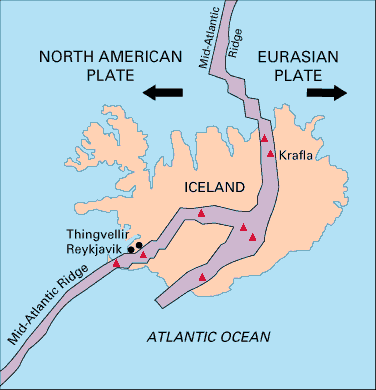Iceland, of course, is located astride the mid-Atlantic Ridge in the North Atlantic Ocean - the boundary between the North American and Eurasian tectonic plates where seafloor spreading is occuring. Why is there a volcanic island here while other areas of the Mid-Atlantic Ridge are far under the surface of the ocean? It appears that there's a mantle plume under Iceland - a column of hot material coming up from the core-mantle boundary (there's one under the Big Island of Hawaii too, in the middle of the Pacific Plate).
Iceland was born of innumerable volcanic eruptions and lava flows since it started forming less than 150 million years ago after the opening of the Atlantic Ocean when the ancient supercontinent of Pangaea split apart. Today there are over 100 volcanoes located throughout the island.
The volcano, a tongue-twisting Eyjafjallajökull, is located under a glacier (a common occurrence for icelandic volcanoes). Lots of glaciers in the interior of Iceland given it's location close to the Arctic Circle although the climate along the coast is moderated by the warm Gulf Stream/North Atlantic Drift currents.
Subglacial volcanoes pose special hazards because as the erupt under a glacial ice sheet hundreds of feet thick, the 1,200 degree Celsius lava easily melts the ice resulting in flash floods bursting out from underneath the glaciers. Geologists describe these events by the Icelandic word jökulhlaup (pronounced "YOKE-uhl-howp" and meaning "glacier burst"). Here are pictures of the waters currently coming from under Eyjafjallajökull glacier.

The ash plume from this volcano has reached the stratosphere and is being blown over Europe. Ash is very bad for jet engines - it's like shoveling sand into it. Airplane engines have been shut down mid-flight after flying through ash (not good over the North Atlantic Ocean). The cost of this to the airline industry is estimated at $200 million/day plus and it can go yet for several weeks to months!
Click here for a really neat animation of the volcanic ash plume moving from Iceland to mainland Europe.
Here are a couple more cool pictures:
By the way, Eyjafjallajökull (a newscasters nightmare) is pronounced "AY-yah-fyaht-lah-yook-kutl" where, in Icelandic, "j" turns into a "y" sound and "ll" turns into a "tl" sound. It means "island-mountain glacier."








how do you pronounce it
ReplyDeletei have a project on this volcaino and i think it would be helpful if i could pronounce it corectly
ReplyDeleteUmm, I mentioned at the end of the post how to pronounce it - "AY-yah-fyaht-lah-yook-kutl"
ReplyDeletestill it is a little hard to pronounce
ReplyDeleteyou should do a post on the Mona Loa
ReplyDeleteWhy should he?
Delete